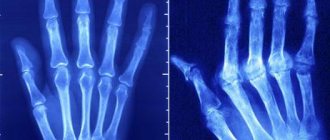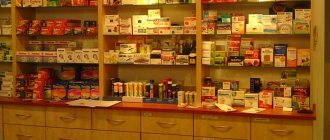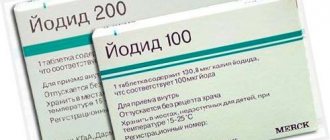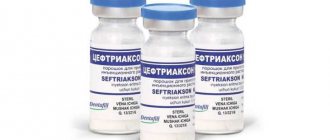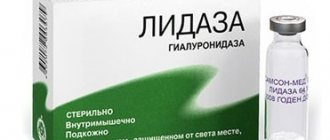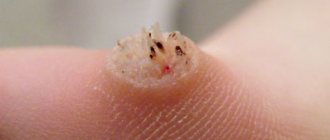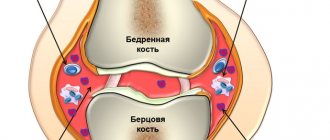Sulfasalazine is prescribed for the treatment of diseases of an autoimmune and inflammatory nature. “Azulfidine” is the main trade name, but on the domestic pharmaceutical market it is represented by medicines with other names. The product has anti-inflammatory and antimicrobial properties. Can be used in children from the age of five. To carry out therapy using this remedy, you need to consult a doctor.
Sulfasalazine is listed on the WHO list of essential medicines.
Release form and composition
The dosage form of Sulfasalazine-EN is enteric-coated tablets: biconvex with beveled edges, round in shape, with a specific odor, with a yellow or brownish-yellow shell; the core in cross section is from brownish-orange to orange (10 pcs in a blister, 5 blisters in a cardboard box).
Composition of 1 tablet:
- active ingredient: sulfasalazine – 500 mg;
- auxiliary components (core): povidone, pregelatinized starch, magnesium stearate, anhydrous colloidal silicon dioxide;
- shell: titanium dioxide, dye yellow iron oxide 10 (E172), macrogol 6000, talc, sodium carmellose, triethyl citrate, copolymer of ethyl acrylate and methacrylic acid (1:1).
Sulfasalazine analogs
In pharmacies you can find various medications with this active ingredient. You need to look at the dosage and dosage form.
Analogues with similar active ingredient in pharmacological properties (mesalazine):
- Asacol in tablets.
- Samesil in tablets and suppositories.
- Mesacol tablets.
Indirect analogue
The analogue can be used only with the permission of the attending physician. The rules of use differ.
Pharmacological properties
Pharmacodynamics
The active substance, sulfasalazine, tends to selectively accumulate in the connective tissue of the intestine, the thickness of the intestinal wall and serous fluid. Thanks to the intestinal microflora, the substance breaks down into sulfapyridine and mesalazine (5-aminosalicylic acid).
Sulfapyridine, suppressing the transformation of lymphocytes and the new formation of T-killer cells, has an antimicrobial effect against streptococci, diplococci, Escherichia coli, and gonococci.
Mesalazine has a significant anti-inflammatory effect in the treatment of the large intestine. The mechanism of action of 5-aminosalicylic acid is the binding of free oxygen radicals, local inhibition of lipoxygenase and cyclooxygenase in the intestinal wall, which prevents the formation of leukotrienes, prostaglandins and other inflammatory mediators.
Pharmacokinetics
- absorption: approximately 30% of the dose of sulfasalazine is absorbed in the wall of the small intestine, the remaining 70% in the large intestine under the influence of intestinal microflora breaks down to form 60–75% sulfapyridine and 25% mesalazine. The maximum concentration of the active substance in the blood plasma is achieved 3–12 hours after taking the drug;
- distribution: binding of sulfasalazine to plasma proteins is 99%, sulfapyridine – 50%, mesalazine – 43%;
- metabolism: sulfapyridine is metabolized in the liver by hydroxylation with the formation of inactive metabolites, mesalazine by acetylation;
- elimination: half-life (T1/2) of sulfasalazine - from 5 to 10 hours, sulfapyridine - from 6 to 14 hours, mesalazine - from 0.6 to 1.4 hours. 5% of sulfapyridine and 67% of mesalazine are excreted through the intestines. 75–91% of sulfasalazine is excreted through the kidneys within three days.
special instructions
Since treatment of severe joint diseases requires a minimum of 3 months, the question often arises whether Sulfasalazine can be combined with alcohol or not. Research on this matter has not been conducted, so there are no clear instructions in the instructions, but since part of the medicine is excreted through the liver, when drinking alcoholic beverages, the load on this organ will increase, which can cause the development of dysfunction.
How does Sulfasalazine affect other drugs:
- reduces the level of absorption of folic acid and Digoxin;
- enhances the therapeutic effect of anticoagulants;
- antibiotics disrupt the balance of intestinal microflora, which leads to a decrease in the effectiveness of Sulfasalazine.
These features should be taken into account when drawing up a treatment regimen, and it is necessary to adjust the dosages of medications.
During treatment, it is necessary to regularly check the functioning of the kidneys, liver, and take a general blood test. The drug can cause an attack of dizziness, so it is recommended to refrain from driving, operating machinery, or doing dangerous work.
Sulfasalazine is a potent drug, so it can only be taken as prescribed by a doctor.
Sulfasalazine is an effective anti-inflammatory drug, but the drug is very potent and has many contraindications, so it can only be taken as prescribed by a doctor; constant supervision by a specialist is required during treatment.
Contraindications
Absolute:
- aplastic anemia, granulocytopenia;
- porphyrin disease;
- severe renal failure;
- severe liver dysfunction;
- congenital deficiency of the enzyme glucose-6-phosphate dehydrogenase;
- lactation period;
- children under 5 years of age; in the treatment of juvenile rheumatoid arthritis – up to 6 years;
- increased individual sensitivity to sulfasalazine or any auxiliary component of the drug, as well as to sulfonamides and salicylic acid derivatives.
Relative (diseases/conditions, the presence of which requires caution when prescribing Sulfasalazine-EN):
- history of allergic reactions (possible cross-allergic reactions to furosemide, sulfonylurea derivatives, thiazide diuretics, carbonic anhydrase inhibitors);
- impaired renal and/or liver function;
- bronchial asthma;
- systemic forms of juvenile rheumatoid arthritis (probability of developing serum sickness);
- pregnancy.
2 Indications when Sulfasalazine is used
The use of Sulfasalazine is justified in cases of inflammatory diseases that occur with symptoms of microbial invasion or the risk of infectious complications. Using the product as an analogue of an antibiotic is inappropriate and in some cases extremely dangerous.
Indications for use:
- nonspecific ulcerative colitis or nonspecific ulcerative proctitis, occurring with mild or moderate severity (the drug is used to relieve exacerbations and as maintenance therapy in the remission phase of the disease),
- Crohn's disease (only moderate or moderately severe forms of the disease during exacerbation; the drug is not suitable for the full treatment of this disease),
- rheumatoid arthritis with severe inflammatory processes that are not controlled by non-steroidal anti-inflammatory drugs (you can read separately about taking Sulfasalazine for arthritis),
- juvenile idiopathic chronic polyarthritis with resistance to treatment with non-steroidal anti-inflammatory drugs.
Healthy and arthritic joint
Sulfasalazine can be used in combination with various corticosteroid drugs and some antimicrobials (for example, the drug has good compatibility with Metronidazole).
2.1 Contraindications
Using Sulfasalazine correctly means making sure in advance that there are no contraindications. It is almost impossible to do this on your own; a comprehensive examination by doctors is necessary (at least at the level of studying biochemical parameters of blood and urine).
Contraindications to Sulfasalazine:
Individual intolerance to one or more components of the drug (presence of allergies). Acute form of porphyria and/or granulocytopenia. Severe deficiency of the enzyme glucose-6-phosphate dehydrogenase. The medication is prohibited for use by children under 5 years of age. Severe liver and/or kidney dysfunction, chronic renal or liver failure. Various types of anemia (including severe iron deficiency anemia), various blood diseases. Intestinal obstruction or compression of the urinary tract. Lactation period (breastfeeding). During pregnancy, the drug is used, but only under the strictest indications
The medication should be used with caution in case of systemic juvenile idiopathic-chronic polyarthritis (the development of serum-like reactions is possible)
2.3 Side effects of Sulfasalazine
Even if you follow all the rules for taking Sulfasalazine, the likelihood of side effects still exists. Side effects develop especially often during long-term or intensive therapy with the accumulation of large concentrations of sulfapyridine in the patient’s blood plasma.
Possible side effects:
- allergic reactions of varying intensity (from itching and urticaria to anaphylactoid reactions and suffocation), serum-like reactions,
- headache, general malaise, fever (up to 38 degrees),
- dyspepsia, bowel dysfunction (including constipation or diarrhea),
- skin itching, development of generalized erythema or allergic dermatitis,
- leukopenia, thrombocytopenia,
- at high dosages of the drug, the development of hemolytic anemia, proteinuria, hematuria and jaundice is possible,
- disorders of the central nervous system, peripheral neuropathy, shortness of breath,
- fibrosing alveolitis, exfoliative dermatitis, nephrotic syndrome and non-infectious hepatitis,
- agranulocytosis, reversible oligospermia and severe cough; in rare cases, reversible and irreversible infertility may develop.
Instructions for use Sulfasalazine-EN: method and dosage
Sulfasalazine-EN 500 mg tablets are taken orally after meals.
Crohn's disease and ulcerative colitis
Recommended dosage regimen:
- adults and children over 16 years of age: first day – 1 tablet (500 mg) 4 times a day; second day – 2 tablets (1000 mg) 4 times a day; the third and subsequent days - 3-4 tablets (1500-2000 mg) 4 times a day. After the acute clinical manifestations of ulcerative colitis have subsided, a maintenance dose is recommended - 1 tablet (500 mg) 3-4 times a day for several months;
- children from 10 to 16 years old and/or weighing from 35 to 50 kg: 1 tablet (500 mg) 4 times a day;
- children from 7 to 10 years: 1 tablet (500 mg) 3-4 times a day;
- children from 5 to 7 years: ½–1 tablet (250–500 mg) 3–4 times a day.
Maintenance therapy is not recommended for children and adolescents under 16 years of age and/or weighing up to 65 kg.
The maximum daily dose of Sulfasalazine-EN is: for adults – 8000 mg (16 tablets), for children under 16 years of age – 2000 mg (4 tablets).
Rheumatoid arthritis and juvenile rheumatoid arthritis
Recommended dosage regimen:
- adults: first week – 1 tablet (500 mg) 1 time per day, second week – 1 tablet (500 mg) 2 times per day, third week – 1 tablet (500 mg) 3 times per day and so on. Possible therapeutic dose is from 1500 mg (3 tablets) to 3000 mg (6 tablets) per day. The course of therapy is six months or more. The clinical effect appears 6–10 weeks after the start of treatment;
- children over 16 years of age and/or weighing more than 50 kg: 2 tablets (1000 mg) 2 times a day;
- children from 12 to 16 years old and/or weighing from 40 to 50 kg: 1 tablet (500 mg) 3 times a day or 2 tablets (1000 mg) 2 times a day;
- children from 8 to 12 years old and/or weighing from 30 to 39 kg: 1 tablet (500 mg) 2-3 times a day;
- children from 6 to 8 years old and/or weighing from 20 to 29 kg: 1 tablet (500 mg) 2 times a day.
For children, the maximum daily dose is 2000 mg (4 tablets of Sulfasalazine-EN 500 mg) or 40–50 mg/kg body weight.
Bottom line
If the patient has stomach problems, then it is better for him to take Sulfasalazine-EN, which will not dissolve in the stomach, but only in the intestines. In a small proportion of patients, in the early stages of taking this group of drugs, fever and skin rashes may occur, which go away on their own after several days of therapy.
Doses of drugs are selected individually, depending on the damage to the intestines and the stage of development of the disease. During the period of exacerbation, the dosage of the drug reaches its maximum, then, as the condition improves, it decreases slightly. If a patient experiences significant side effects while taking medications, this should be reported to the attending physician. According to patients, there is no significant difference between the drugs. The only difference from Sulfasalazine is that the drug dissolves in the stomach and can cause pain in the epigastric region.
If you regularly take the tablets according to the indicated regimen, you can stop the process of bone destruction in rheumatoid arthritis. The medicine can be prescribed to adults and children over 5 years of age. The dosage should not be exceeded so as not to cause side effects that can lead to serious complications in other organs and systems. It is also better to take tablets immediately after meals and wash them down with alkaline solutions, such as mineral water. After just one month of treatment, improvement will be observed. The medicine is prescribed for a long period, but is not addictive and O syndrome and “Sulfasalazine” are available at the pharmacy with a prescription.
Side effects
The development of adverse reactions depends on the level of sulfapyridine concentration in the blood plasma, especially in patients with slow acetylation. More often, undesirable effects are observed in patients with rheumatoid arthritis.
Possible adverse reactions when using Sulfasalazine-EN from systems and organs:
- central and peripheral nervous system: dizziness, headache, convulsions, vertigo, hallucinations, tinnitus, sleep disturbances, peripheral neuropathy, depression, aseptic meningitis, ataxia;
- digestive system: diarrhea, nausea, loss of appetite, vomiting, abdominal pain, pancreatitis, drug-induced hepatitis, anorexia;
- urinary system: hematuria, proteinuria, crystalluria, interstitial nephritis, renal dysfunction;
- hematopoietic system: neutropenia, leukopenia, macrocytosis, hemolytic anemia, megaloblastic anemia caused by the carriage of unstable hemoglobins (due to the presence of Heinz-Ehrlich bodies), hemolytic anemia, agranulocytosis, methemoglobinemia, thrombocytopenia, hypoprothrombinemia, aplastic anemia;
- respiratory system: cough, shortness of breath, interstitial pneumonitis, infiltrates in the lung tissue, fibrosing alveolitis;
- reproductive system: transient oligospermia, infertility;
- allergic reactions: skin itching, erythema, urticaria, generalized skin rash, Lyell's syndrome (toxic epidermal necrolysis), Stevens-Johnson syndrome (malignant exudative erythema), exfoliative dermatitis, fever, serum sickness, photosensitivity, lymphadenopathy, polyarteritis nodosum, eosinophilia, periorbital swelling, anaphylactic shock;
- laboratory tests: increased alkaline phosphatase activity, hyperbilirubinemia, increased levels of liver transaminases;
- other: mumps, hyperthermia, possible yellow discoloration of skin, urine or soft contact lenses.
Description of the drug
The drug Sulfasalazine is used to treat arthritis
Sulfasalazine is actively used in the treatment of rheumatoid arthritis in adults when a positive result is not achieved with nonsteroidal anti-inflammatory drugs (NSAIDs).
Sulfasalazine is available in the form of dark yellow tablets with brown inclusions, coated with a protective coating. Each tablet has a round shape, convex on both sides. The medicine is packaged in blisters of 10 pieces each.
One tablet contains 500 mg of active substance. It is a compound of sulfapyridine with 5-aminosalicylic acid. Excipients in the tablets include: povidone, pregelatinized starch from corn grains, magnesium stearate, colloidal anhydrous silicon dioxide, hypromellose, propylene glycol. In clinical trials of Sulfasalazine, incl. in the treatment of rheumatoid arthritis, it has been proven that it is not inferior in effectiveness to other disease-modifying anti-inflammatory drugs (DMARDs).
In the treatment of polyarticular or oligoarticular rheumatoid arthritis, the use of sulfasalazine is prescribed in complex therapy, taking into account the results of biomaterial analyzes and other studies that are necessary to determine a clear clinical picture of the disease. The first course of treatment should last at least six months, only in this case can you count on a positive result.
The above-mentioned drug has the characteristic of a prolonged (long) decay process and is concentrated in the blood. The presence of such properties determines the likelihood of side effects that can sometimes be observed in patients. If they occur, it is recommended to consult with your doctor for possible dosage adjustment or replacement with another drug of similar pharmacological action.
Overdose
In case of an overdose of Sulfasalazine-EN, the following symptoms may appear: dizziness, abdominal pain, nausea, vomiting. If very high doses of the drug are taken, symptoms of nervous system intoxication (convulsions), hematuria, anuria, and crystalluria may occur.
Recommended treatment for overdose is symptomatic. You should induce vomiting, rinse the stomach and intestines, alkalize urine, and force diuresis. In patients with anuria and/or renal failure, fluid and electrolyte intake should be limited.
Compatibility and application features
Sulfasalazine EH should not be taken with digoxin and folic acid, as the drug reduces their effectiveness. The same applies to antibacterial drugs.
Sulfasalazine EH, on the contrary, enhances the effect of anticoagulants.
The drug is not compatible with alcohol. However, it is allowed to take tablets a few hours after drinking wine or cognac.
For pregnant women, Sulfasalazine EH is prescribed only when there is a threat to life and in the smallest effective dose. It binds to blood proteins by 99% and easily crosses the placental barrier.
The drug should not be used when breastfeeding. Use is allowed only if the child can be transferred to artificial feeding.
Drug interactions
- folic acid, digoxin: decreased absorption;
- anticoagulants, antiepileptics and oral hypoglycemic agents: enhancing their effect;
- cytostatics, immunosuppressants, hepato- and nephrotoxic drugs: increased side effects;
- drugs that have a depressing effect on bone marrow hematopoiesis: increased risk of myelosuppression;
- antibiotics: decreased effectiveness of sulfasalazine in ulcerative colitis (due to the inhibitory effect of antibiotics on intestinal microflora).
Special Recommendations
To achieve maximum results from taking the medication, the patient needs not only to regularly take the pills in the prescribed amount, but also to consider how best to use them. It is extremely important to know which medications Sulfasalazine can be combined with and which ones cannot. It must be remembered that the drug has the following actions:
It must be remembered that the drug has the following actions:
- enhances the effect of anticoagulants used;
- increases the effect of antiepileptic drugs and hypoglycemic drugs several times;
- when combined with cytostatics, there is a risk of manifestation and increased side effects from the latter group of drugs;
- The compatibility of the drug with Azathioprine is strictly not recommended, as it increases its toxicity;
- If the patient is prescribed ampicillin, the effect of Sulfasalazine may be reduced. Neomycin also acts on this drug in the same way.
If the patient is prescribed this drug, you also need to remember the following recommendations:
If, while taking the drug, the patient develops kidney problems or the organ begins to function worse, further therapy should be carried out with extreme caution. This complication may also require the use of a sulfasalazine substitute. Despite the lack of studies that would confirm that this medication should not be combined with alcohol, most experts still do not recommend consuming alcohol during therapy. To minimize the risk of complications and side effects, the patient should take as much fluid as possible during therapy.
Moreover, it should not be coffee or tea, but ordinary filtered water. If the patient is prescribed long-term treatment (more than 2 months), it is recommended to periodically go to the hospital and take tests that can help monitor how the kidneys and liver are working. If a person takes any other medications on an ongoing basis, it is imperative to notify the attending physician.
Practical application experience
After Sulfasalazine appeared on the market, he introduced it into prescriptions for the treatment of his patients with rheumatoid arthritis on an ongoing basis. Over the years of practice, the product has shown itself to be exceptionally good, is easily accepted by patients and helps to significantly slow down the development of RA.
Ivan Vasilievich, rheumatologist, Moscow
Rheumatoid arthritis is not uncommon in my practice. Recently I decided to include a drug such as Sulfasalazine in the treatment program. Surprisingly, it actually works well.
Daria Petrovna, doctor, Tomsk
I have serious problems with my joints: my legs hurt and were swollen, it was difficult to walk normally. The specialist diagnosed RA. Sulfasalazine was prescribed. Literally 2-3 weeks after starting to take it, I felt significant relief. Maria, 43 years old, Moscow
I have been struggling with joint pain for a long time. I took different medications, but they helped with varying degrees of success. One experienced doctor advised the use of Sulfasalazine. I’ve only been taking this remedy for a month, but the results are very pleasing, the pain and inflammation have subsided significantly.
Ivan, 52 years old, St. Petersburg
Pregnancy
Information collected as a result of studies of pregnant patients does not give grounds to talk about any negative effects of this drug on the course of pregnancy, the health of the embryo and newborn.
For pregnant women, it is recommended to take sulfasalazine in the minimum effective doses. The drug is not recommended during the last three months of pregnancy, since it displaces bilirubin in the body and therefore can lead to kernicterus in newborns, as well as (in the case of a lack of glucose-6-phosphate dehydrogenase in the newborn) - to anemia of hemolytic etiology.
An extremely small portion of the dose taken passes into breast milk, so for a healthy newborn the likelihood of kernicterus is very low. Statistics confirm this.
But problems arise in premature and some other categories of newborns that are considered risky.
The content of sulfapyridine in breast milk reaches a level of approximately 40 percent of the content of this substance in the blood plasma, but sulfapyridine binds to plasma proteins to a small extent. The effect of the drug on infants during breastfeeding remains insufficiently studied, therefore lactation during the course of taking this drug is undesirable.
Features of treatment of rheumatoid arthritis
Sulfasalazine is a drug from the sulfonamide group. It has an anti-inflammatory effect. In this case, the drug must be used in long courses, up to six months. To get the first positive effects, it is necessary to continue regular treatment for 6-10 weeks.
The dosage and number of uses are determined by the doctor, as well as the duration of the course. This will largely depend on the patient's condition. It is also important to choose the right concomitant medications and procedures that will help enhance the effect of Sulfasalazine. To do this, it will be necessary to undergo a high-quality examination, pass tests that determine the severity of autoimmune processes occurring in the body, as well as the presence of contraindications to the use of medications.
The drug is available in the form of tablets that are taken orally. To use this form of the drug, you must consume large amounts of water. It is important to understand that for children under 16 years of age, the dosage is prescribed according to body weight, that is, only a doctor can calculate it. If you experience any side effects from the drug, you should stop taking the pills until you consult your doctor.
Important! The medication is allowed for use during pregnancy if the dosage is reduced to an acceptable therapeutically effective level.
Treatment of this autoimmune disease is always carried out comprehensively, otherwise any effect will be fragmentary and short. A correctly administered course of treatment is the key to rapid onset of remission with maximum duration.
Don't miss: Treatment of rheumatoid arthritis of the knee
Therapy includes:
- drug treatment (NSAIDs, corticosteroids, immunosuppressants, etc.);
- surgery;
- treatment with folk remedies;
- physiotherapy;
- massage and exercise therapy;
- diet therapy.
Part of the drug treatment is Sulfasalazine, which contains the active ingredient of the same name.
Indications for use
The main area in which Salofalk has found application is the treatment of ulcerative colitis and Crohn's disease.
The first disease is a chronic inflammatory process of an as yet unclear nature. Its development is determined by the interaction of genetic factors and environmental conditions.
Crohn's disease can be characterized as a chronic granulomatous inflammation of the gastrointestinal tract. This process can involve all parts of the digestive system and affects all layers of the digestive tube. The consequence may be the development of lymphadenitis, the formation of scars and ulcerations on the intestinal walls.
Substitutes
An effective replacement, which is an absolute analogue of the medication - “Sulfasalazine-EN”. The drugs are completely identical, the only difference is the shell, which is enteric-soluble in the analogue, so the dissolution of such tablets occurs in the intestines. “Sulfasalazine” enters directly into the stomach, having a negative effect on it, so patients often suffer from a burning sensation in the esophagus after taking a dose of the medicine.
If it is not possible to take Sulfasalazine in the fight against rheumatoid arthritis, its therapeutic effect can be replaced by one of the following analogues:
The replacement of the medication must be agreed with the doctor.
- "Mesacol";
- "Celeston";
- "Azathioprine";
- "Hydrocortisone";
- "Fortecortin";
- "Enterosan";
- "Alginatol";
- "Yogulact";
- "Triamcinolone";
- "Lemod";
- "Pentas"
- "Salofalk";
- "Eglonil";
- "Multofer";
- "Urbazon";
- "Prednisolone."
Storage, release from pharmacies
The drug Sulfasalazine can only be purchased by providing a prescription form from a specialist. The drug must be stored in a dry room at a temperature not exceeding 25°C. It is not recommended to store the drug in the refrigerator. The shelf life is five years from the date of production. It is prohibited to use the medicine after the expiration date. The year of the last adjustment of the means is 2010.
Article on the topic: What diseases can cause pain in the thoracic spine
Reviews
Ekaterina, 33 years old, Chelyabinsk “I have ulcerative colitis, which, fortunately, does not bother me very often, but exacerbations are very violent - with constant diarrhea and pain from any food. Among all the drugs prescribed to me by doctors, I prefer sulfasalazine, partly because of the low price. I personally have not had any side effects yet. Diarrhea and pain go away thanks to it, so I have no complaints about this remedy.”
Svetlana, 46 years old, Moscow “When I was diagnosed with ulcerative colitis, they prescribed sulfasalazine and I felt better. The course of taking this remedy is quite long, but it is still better than constantly suffering. My problem was solved, I achieved remission. The drug has no taste at all, so taking it does not cause any unpleasant sensations.”
When is the medication used?
The medicine is prescribed for the following pathologies:
- UC;
- Crohn's disease;
- rheumatoid arthritis.
It is prohibited to take the medicine in the following cases:
- kidney and liver disease;
- anemia;
- porphyria;
- pregnancy;
- lactation;
- hypersensitivity to substances included in the drug.
Before starting the treatment process, it is necessary to carefully study all contraindications to taking the drug “Sulfasalazine-EN”. Difference from “Sulfasalazine, special instructions - all information is important. The drug can be used after consultation with a specialist.
